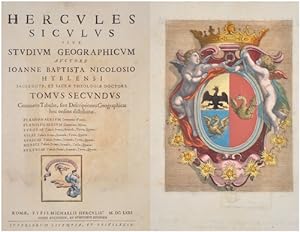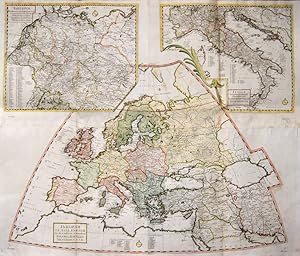nicolosi giovanni battista rome (2 resultados)
ComentariosFiltros de búsqueda
Tipo de artículo
- Todos los tipos de productos
- Libros (1)
- Revistas y publicaciones (No hay ningún otro resultado que coincida con este filtro.)
- Cómics (No hay ningún otro resultado que coincida con este filtro.)
- Partituras (No hay ningún otro resultado que coincida con este filtro.)
- Arte, grabados y pósters (1)
- Fotografías (No hay ningún otro resultado que coincida con este filtro.)
- Mapas (No hay ningún otro resultado que coincida con este filtro.)
- Manuscritos y coleccionismo de papel (No hay ningún otro resultado que coincida con este filtro.)
Condición
- Todos los libros
- Nuevos (No hay ningún otro resultado que coincida con este filtro.)
- Antiguos o usados (2)
Encuadernación
- Todas
- Tapa dura (No hay ningún otro resultado que coincida con este filtro.)
- Tapa blanda (No hay ningún otro resultado que coincida con este filtro.)
Más atributos
- Primera edición (No hay ningún otro resultado que coincida con este filtro.)
- Firmado (No hay ningún otro resultado que coincida con este filtro.)
- Sobrecubierta (No hay ningún otro resultado que coincida con este filtro.)
- Con imágenes (2)
- No impresión bajo demanda (2)
Gastos de envío gratis
- Envío gratis a España (No hay ningún otro resultado que coincida con este filtro.)
Valoración de los vendedores
-
Hercules Siculus sive Studium Georgraphicum Auctore Joanne Baptista Nicolosio Hyblensi sacerdote, et sacrae theologiae Doctore Tomus Secundus.
Publicado por Artist: Nicolosi Giovanni Battista ( - 1670 ) Rome ; issued in: Rome; - Giovanni Battista Nicolosi (1610 ?1670) was a priest and cartographer commissioned in 1652 by the Propaganda Fide to produce this atlas which was first issued in 1660 It became Nicolosi's Dell' Hercole e Studio Geografico The 4 sheet maps of the continents have become highly sought after by collectors incorporating Nicolosi's meticulous work and novel presentation style It contains a double-hemisphere world map largely derived from Nicolas Sanson and is a model of clarity omitting any decorative features The four maps of North America 'Mexicum' contain many more place names in this second edition South America and Africa are oriented with South at the head of the sheets, 1610
Librería: Antique Sommer& Sapunaru KG, München, Alemania
Arte / Grabado / Póster
Technic: Copper print, colorit: original colored, condition: Tearat outer margin perfectly restored, size (in cm): 22 x 16,5 cm; - Title page of "Hercules Siculus sive Studium Georgraphicum Auctore Joanne Baptista Nicolosio Hyblensi sacerdote, et sacrae theologiae Doctore Tomus Secundus. "Publisher: Typis Michaelis Herculis. The reverse of the title page shows a representation of a coat of arms surrounded by a crown, a chain of orders and two putti.; History: The history of heraldry is divided into three main periods. The time from around the 11th to the 13th century when the shield with the image represents the actual coat of arms. Then the period from about the 13th to the 15th century, the heyday of heraldry, in which helmets and jewelry (such as wings, feathers, horns, hats, hulls) are added to the shield. This was followed by the period since the 16th century, when the shield was no longer used as a weapon, but only as a badge of honor and more and more insignificant ingredients were added. It was customary for the warriors and especially the military leaders of the peoples of Babylon, Persia and China to put various symbols and figures on their shields and flags. Various animals such as lions, horses, dogs, boars and birds can also be found on the shields of the ancient Greeks. Furthermore, the legions and cohorts of Rome also had their own symbols and insignia. With the rise of feudalism in the Middle Ages, the ruling houses chose their own symbols. During the great campaigns, dozens of noble houses were able to move out together, and their armor had increasingly fewer design differences. The colors and symbols on the shields became increasingly important, and several colors were combined in simple geometric shapes. Another reason for showing coats of arms was provided by knight tournaments, which were both a weapon exercise and an exhibition. Those who were defeated in a duel often lost their horse and armor, which was very expensive at the time. The knights could hardly be recognized under the full armor of the early 12th century, so the tournament participants wore their own coat of arms or that of their liege lord on the shields. The importance of knight tournaments waned with the burgeoning renaissance, and the rapid spread of firearms in the 16th century quickly put an end to the confrontation with shield, lance, armor and sword. In the meantime, however, the coats of arms also had a sovereign function. Most of the knights of the Middle Ages were illiterate, but knowing the symbols of the coat of arms allowed them to assign documents. The heraldic elements lost their intrinsic value and were partly used again purely for decorative purposes as a mere filling of lavishly designed cartouches.
-
Europam et Asiae Partem / Imperium Romano-Germanicum / Italia Secundum Dominatus.
Publicado por Artist: Nicolosi Giovanni Battista ( - 1670 ) Rome ; issued in: Rome; - Giovanni Battista Nicolosi (1610 ?1670) was a priest and cartographer commissioned in 1652 by the Propaganda Fide to produce this atlas which was first issued in 1660 It became Nicolosi's Dell' Hercole e Studio Geografico The 4 sheet maps of the continents have become highly sought after by collectors incorporating Nicolosi's meticulous work and novel presentation style It contains a double-hemisphere world map largely derived from Nicolas Sanson and is a model of clarity omitting any decorative features The four maps of North America 'Mexicum' contain many more place names in this second edition South America and Africa are oriented with South at the head of the sheets, 1610
Librería: Antique Sommer& Sapunaru KG, München, Alemania
Technic: Copper print, colorit: original colored, condition: Very good, size (in cm): 77,5 x 89,5; - Map shows Europe, on inset map Italy and Germany ( Imperium Romano Germanicum).He was following the tradition of Italian mapmakers of the 16h Century, such as Bertelli and Ramusio.; History: Especially the Greek culture, the Roman Empire and Christianity left their mark until today. In ancient times, the Roman Empire at the time of Augustus united for the first time the entire southern Europe together with the other coastal countries of the Mediterranean in one great empire. In the Roman Empire, the new religion of Christianity was able to spread rapidly. In the early Middle Ages, the Paderborn Epic declared the ruler of the Frankish Empire, Charlemagne, to be the "Father of Europe." The Middle Ages were marked, among other things, by competition between the new Roman emperor in the West and the Byzantine emperor in Constantinople, in the East, to whose two spheres of influence the later deepened division into a Western and Eastern Europe can be traced. Since the 15th century, European nations (especially Spain, Portugal, Russia, the Netherlands, France, and the United Kingdom of Great Britain and Northern Ireland) built colonial empires with large possessions on all other continents. Europe is the continent that has influenced the other continents the most, for example, through Christian missionary work, colonies, slave trade, exchange of goods and culture. n the 18th century, the Enlightenment movement set new directions and demanded tolerance, respect for human dignity, equality and freedom. In France, the French Revolution brought the bourgeoisie to power in 1789. In the early 19th century, half of Europe had to conform to the will of Napoleon, the French emperor who came to power after the revolutionary period, until he suffered a fiasco in Russia in 1812. The conservative victorious powers then tried to restore pre-revolutionary conditions at the Congress of Vienna, which succeeded only temporarily. Industrialization began in parts of Europe in the 18th century and rapidly changed the everyday lives of broad sections of the population.



